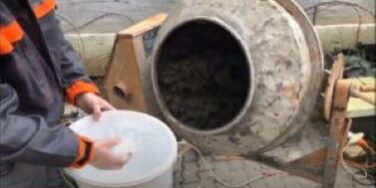Or: how do we mix ArmoTec macro fiber into the concrete?
The use of ArmoTec macro fiber is no more complicated than adding any other additive, such as dosing cement.
The typical expected mixing ratio for concrete is as follows:
- 5 units of aggregate
- 1 unit of cement
- 0.6 units of water
The unit refers to the mass ratio, meaning it’s not a shovel or bucket, but kilograms.
If you want to make higher compressive strength concrete, you can increase the amount of cement, up to a maximum of one-third of the aggregate.
It would be great if we could measure the materials by weight rather than volume when making concrete, but I’ve seen few “enthusiastic” laborers carrying a kitchen scale in their bag to work.
For home-mixed concrete, you probably won’t go wrong with a mix of 1 shovel of cement to 4 shovels of aggregate, and add enough water so it doesn’t flow apart! Concrete that’s too watery is harmful to health and significantly reduces concrete quality. When it evaporates, there’s a much higher risk of cracking.
The dosage of ArmoTec is always specified per cubic meter of concrete, for example, 3 kg/m3.
- If we order concrete from a concrete plant, it’s simple because we can instruct them to add a certain amount per cubic meter. This can be added directly to the mixer or the concrete truck. The use of macro fibers is familiar to most concrete plants. If someone hasn’t heard of it, there might be something wrong with that concrete plant.
2. The ArmoTec macro fiber should be added last as an admixture, and it should be mixed at full speed for 1 minute per cubic meter.
(These mixer trucks can transport 7-10 m3 of concrete, so if they mix the concrete for 10 minutes after adding the macro fiber, everything will be fine.)
You can watch the process in the following video:
You can only use ArmoTec if you didn’t fail math in elementary school 😅. If you did, you won’t be able to do concrete work either. But that’s not you. Using macro fibers is incredibly simple, which is why it’s so popular: it completely eliminates the hassle of dealing with steel mesh.
I illustrate home dosing through this simple example. (In our case, the required dosage is 3 kg/m3.)
- We need to measure the capacity of our concrete mixer to know how much ArmoTec we should put into one mix.
- We can easily do this by preparing a batch of concrete and pouring it into buckets whose volume we either know or measure with water. After that, we can easily calculate the capacity of our mixer in liters.
- The most common concrete mixers are 120-150 liters in capacity, but you can only fill them halfway with concrete. This means you can prepare approximately 60-70 liters of concrete with them.
- In the example, we need to add 4 kg of ArmoTec to 1 m3 of concrete. With our concrete mixer, we could prepare 50 liters of concrete at once, which is 1/20th of 1 m3.
- So, we divide 3 kg by 20, and the result is: 0.15 kg, which is 150 grams of ArmoTec needed per mix.
- We pour back the measured concrete into the mixer and add the 150 grams of macrofiber, measured with the kitchen scale.
- Mix it for 2-3 minutes, and our brutally strong super concrete is ready.
If you don’t want to hassle with steel mesh during your next concrete pouring, visit this website and easily order macro fibers from home: betonbooster.com
With friendship,
Levente Siposs
supporter of sustainable renovations
Manufacturer’s website of ArmoTec








